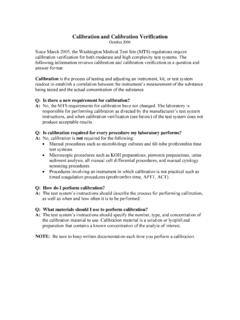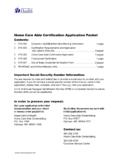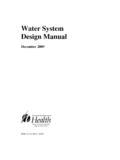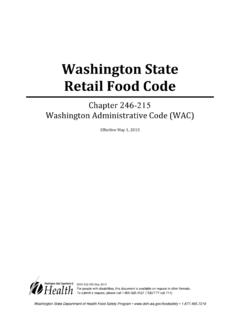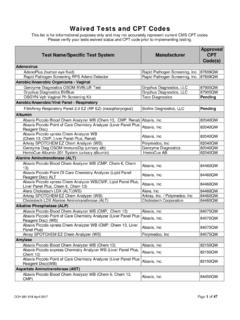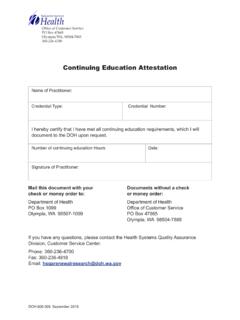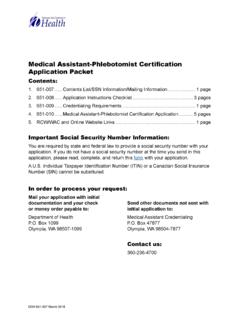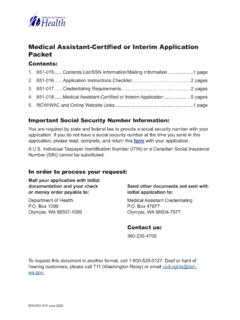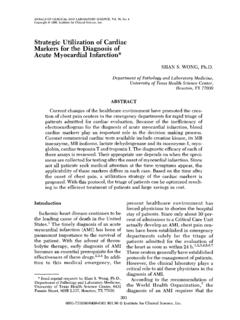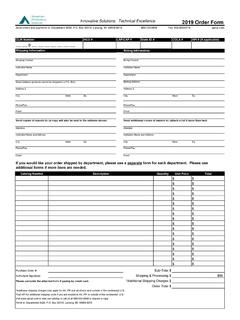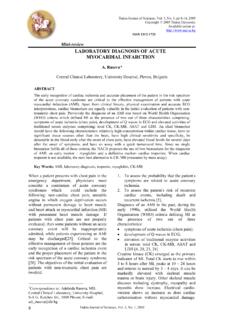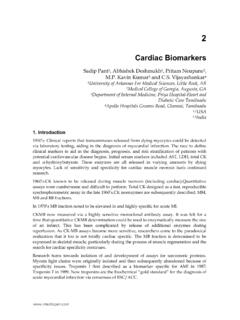Transcription of State of Washington Prehospital Cardiac Triage Destination ...
1 Assess Transport Time and Determine Destination by Level of Prehospital Care* BLS/ILS ALS Unstable patients (life-threatening arrhythmias, severe respiratory distress, shock) unresponsive to EMS treatment should be taken to the closest hospital. YES * Slight modifications to the transport times may be made in county operating procedures. See page 2. Consider ALS and air transport for all transports greater than 30 minutes.
2 If there are two or more Level I facilities to choose from within the transport timeframe, patient preference, insurance coverage, physician practice patterns, and local rotation agreements may be considered in determining Destination . This also applies if there are two or more Level II facilities to choose from. State of Washington Prehospital Cardiac Triage Destination Procedure Assess Applicability for Triage Post Cardiac arrest with ROSC -OR- 21 years of age with symptoms lasting more than 10 minutes but less than 12 hours suspected to be caused by coronary artery disease: Chest discomfort (pressure, crushing pain, tightness, heaviness, cramping, burning, aching sensation), usually in the center of the chest lasting more than a few minutes, or that goes away and comes back.
3 Pain or discomfort in 1 or both arms, neck, jaws, shoulders, or back. Shortness of breath with or without chest discomfort. Epigastric (stomach) discomfort, such as unexplained indigestion, belching, or pain. Other symptoms may include sweating, nausea/vomiting, lightheadedness. NOTE: Women, diabetics, and geriatric patients might not have chest discomfort or pain. Instead they might have nausea/vomiting, back or jaw pain, fatigue/weakness, or generalized complaints. NO Transport per regional patient care procedures YES Assess Immediate Criteria Post Cardiac arrest with return of spontaneous circulation Hypotension or pulmonary edema EKG positive for STEMI (if available) NO YES If EMS personnel still suspect an acute coronary event, contact medical control for Destination .
4 If not, transport per regional patient care procedures. If ALS has not been dispatched, upgrade if available. NO DOH 346-050 April 2011 NO Level I Cardiac Hospital w/in 30 minutes YES Level I Cardiac Hospital w/in 60 minutes YES NO Assess High Risk Criteria In addition to symptoms in Box 1, pt. has 4 or more of the following: Age 55 3 or more CAD risk factors: family history high blood pressure high cholesterol diabetes current smoker Aspirin use in last 7 days 2 anginal events in last 24 hours, including current episode Known coronary disease ST deviation (if available) Elevated Cardiac markers (if available) YES NO YES NO Level II Cardiac Hospital 60 minutes closer than Level I?
5 Go to Level I Cardiac Hospital and alert Destination hospital en route ASAP Level II Cardiac Hospital 30 minutes closer than Level I? Go to Level I Cardiac Hospital and alert Destination hospital en route ASAP Go to closest Level II Cardiac Hospital and alert Destination hospital en route ASAP YES Why Triage Cardiac patients? The faster a patient having a heart attack or who s been resuscitated gets treatment, the less likely he or she will die or be permanently disabled. Patients with unstable angina and non-ST elevation acute coronary syndromes (UA/NSTE) are included in the Triage procedure because they often need immediate specialized Cardiac care.
6 This Triage procedure is intended to be part of a coordinated regional system of care that includes dispatch, EMS, and both Level I and Level II Cardiac Hospitals. How do I use the Cardiac Triage Destination Procedure? A. Assess applicability for Triage If a patient is post Cardiac arrest with ROSC, or is over 21 and has any of the symptoms listed, the Triage tool is applicable to the patient. Go to the Assess Immediate Criteria box. NOTE: Women, diabetics, and geriatric patients often have symptoms other than chest pain/discomfort so review all symptoms with the patient.
7 B. Assess immediate criteria If the patient meets any one of these criteria, he or she is very likely experiencing a heart attack or other heart emergency needing immediate specialized Cardiac care. Go to Assess Transport Time and Determine Destination box. If the patient does not meet immediate criteria, or you can t do an ECG, go to the Assess High Risk Criteria box. C. Assess high risk criteria If , in addition to meeting criteria in box 1, the patient meets four or more of these high risk criteria, he or she is considered high risk for a heart attack or other heart emergency needing immediate specialized Cardiac care.
8 These criteria are based on the TIMI risk assessment for unstable angina/non-STEMI. If the patient does not meet the high risk criteria in this box, but you believe the patient is having an acute coronary event based on presentation and history, consult with medical control to determine appropriate Destination . High risk criteria definitions: 3 or more CAD (coronary artery disease) risk factors: Age 55: epidemiological data for WA show that incidence of heart attack increases at this age Family history: father or brother with heart disease before 55, or mother or sister before 65 High blood pressure: 140/90, or patient/family report, or patient on blood pressure medication High cholesterol: patient/family report or patient on cholesterol medication Diabetes: patient/family report Current smoker: patient/family report.
9 Aspirin use in last 7 days: any aspirin use in last 7 days. 2 anginal events in last 24 hours: 2 or more episodes of symptoms described in box 1 of the Triage tool, including the current event. Known coronary disease: history of angina, heart attack, Cardiac arrest, congestive heart failure, balloon angioplasty, stent, or bypass surgery. ST deviation mm (if available): ST depression mm is significant; transient ST elevation mm for < 20 minutes is treated as ST-segment depression and is high risk; ST elevation >1 mm for more than 20 minutes places these patients in the STEMI treatment category.
10 Elevated Cardiac markers (if available): CK-MB or Troponin I in the "high probability" range of the device used. Only definitely positive results should be used in Triage decisions. D. Determine Destination The general guideline is to take a patient meeting the Triage criteria directly to a Level I Cardiac Hospital within reasonable transport times. For BLS, this is generally within 30 minutes transport time, and for ALS, generally 60 minutes transport time. See below for further guidance. Regional patient care procedures and county operating procedures may provide additional guidance.
